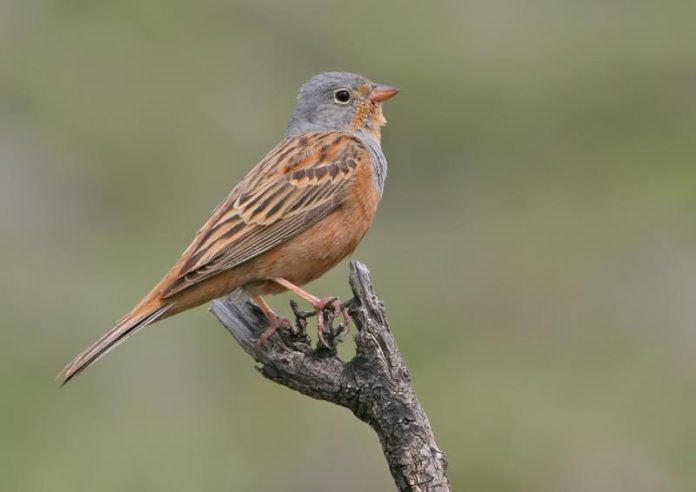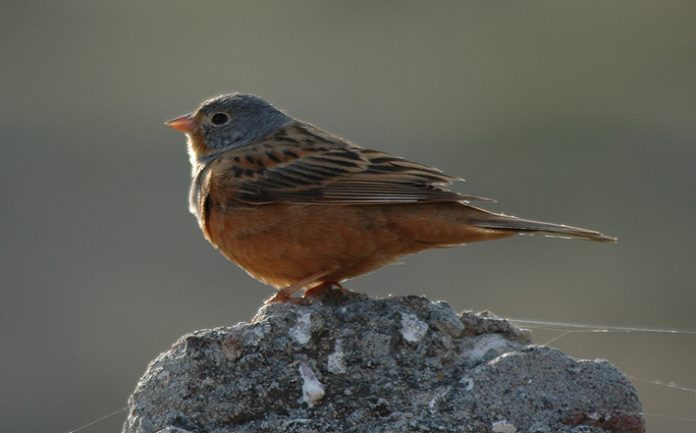Cretzschmar’s Bunting is found in the Eastern Mediterranean region. A bright pink bill and prominent pale eye-ring prevent confusion with most other buntings in all plumages, but these characteristics are shared by Ortolan and Gray-necked (range overlaps only with that of Ortolan). It is slightly smaller and sleeker than Ortolan, with a comparatively shorter tail and a slightly smaller, shorter bill.

Adult and some first-winter males differ from Ortolan in having bright (male) or dull (female) bluish-gray heads and breast and orange-rufous (male) or buff (female) throat and sub-moustachial stripes; various Ortolan, particularly females, have grayish-olive head and breast which can suggest Cretzschmar’s but their throats and sub-moustachial stripes are pale yellows, never orange-rufous or buff.
The mantle, scapular, and back are warm rufous-brown (i.e. much warmer than in Ortolan), lacking the contrast with the rusty scapulars shown by both Ortolan and Grey-necked (most noticeably in fresh males), and the rump is strongly tinged with rufous (uniformly olive-brown in Ortolan).
The first-winter female is heavily streaked below, differing from Ortolan in much the same way as adults: i.e. warmer brown (not olive-brown) coloration above, with a distinct rufous wash to rump, pale buffish (not pale yellowish) throat, and sub-moustachial stripe, greyer ground color to head and neck and warmer buff lower underparts.
A number of individuals are problematic, showing an olive wash to the gray-brown of the head (i.e. suggestive of Ortolan), but the strong blackish crown streaking of Cretzschmar’s gives a somewhat capped appearance (crown streaking less sharply defined in Ortolan). On the hand, the underwing coverts are whitish, tinged rufous (pale yellow in Ortolan).
Gray-necked differs in being paler, almost grayish sandy-brown, above, with weak, diffuse streaking on the mantle, has pinker-rufous underparts which become almost whitish on lower belly, and lacks breast band). A warm rufous appearance in flight may even suggest House Bunting if the tail is closed and white corners not visible, but white is evident when the tail spread on landing. Compare also female Rock Bunting.
The juvenile bird is profoundly streaked and almost positively indistinguishable from juvenile Ortolan. It is most simply told from juvenile Rock Bunting by having rump and uppertail coverts buffy (with dark streaks) rather than rufous. It is generally less arboreal than Ortolan, singing from the ground or bushes rather than trees.
On passage, it is usually in small parties. In contrast, many buntings have pre-breeding molt. Sexes are similar, but adult female summer is duller overall compared with adult male summer, with an obvious brown tinge to the grey of the head, neck, and breast band, fine dark streaking on the crown and upper breast, and throat and sub-moustachial stripe buff or cinnamon-buff rather than orange-rufous.
In winter plumage, both sexes are duller than in respective summer plumage, females having pale buffish throat and sub-moustachial stripe. The juvenile more heavily streaked above, with obvious dark streaking across the breast and along the upper flanks. The first-winter males mostly resemble adult females winter, but breasts and heads are duller and more streaked; some, however, are inseparable from adult males.
The first-winter female very heavily streaked below. The first-summer male is very comparable to an adult, but grey areas are often duller and the belly is less intense and rusty-rufous; first-summer females are often indistinguishable from adults but some show heavier streaking on the crown and upper breast, and paler belly.
Cretzschmar’s Bunting usual call differs from that of Ortolan Bunting: a sharper, harsher, more metallic, and more chirped ‘tchip’ or ‘styip’; also gives a piping ‘cheu’ when agitated. Song distinctly thinner and higher in pitch than that of Ortolan, and often shorter, characteristically a plaintive, rising, rather wheezy ‘tseee-tseee-tseee tsew’ or more musical variant; the song has only one terminal note, and this is drawn-out rather than ringing as in Ortolan (which often utters just one terminal note in the south of range).
Cretzschmar’s Bunting is a locally common bird. The bird favors drier habitats than Ortolan Bunting, typically dry, rocky hillsides with scattered bushes (and sometimes trees), also edge of small areas of cultivation, up to about 1300 meters. On passage, the bird is frequently found in stubble fields and other cultivation.







